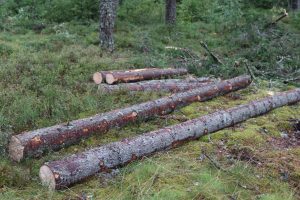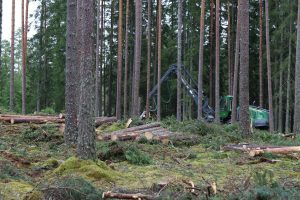The group, called “For Forest Group”, consists of Austria, Finland, Slovenia, and Sweden, and its purpose is to defend the interests of the national forest industries in the EU according to an article in the Helsinki Times.
EU countries team up to defend the forestry business
The Forest Group claims that the preparations for the EU Commission’s upcoming proposal on collecting data and monitoring the state of the EU forests haven’t included the member states enough.
“You shouldn’t create a new system at the EU level. The supreme authority in forest policy belongs to the member states”, said Antti Kurvinen, the Finnish minister of agriculture and forest.
To try to squeeze all EU member states into the same forest policy is wrong, according to the For Forest Group. A lack of forestry expertise in Brussels has led to decisions being made on the wrong facts.
The core of the group
The well-forested countries Austria, Finland, Slovenia, and Sweden form the core of the group. Other EU member states can contribute and already a total of 19 member states support the initiative. They represent approx. 80 percent of the forested area of the EU.
The target is to share knowledge and experiences between the countries, but most of all to influence all forestry-related decision-making on the EU level toward a sustainable forest policy. The four countries in the group have a long tradition, experience, and expertise in forest management, something that is missing in the EU and that the For Forest Group wishes to change for the better.
The plan is to have an annual forest conference starting in Austria in 2023.
The EU Forest Strategy for 2030
The new EU Forest Strategy for 2030 is very much discussed, not least in the Nordic countries Finland and Sweden. We also wrote about it here at nordicwoodjournal.com. The reason is obvious as the forestry business in those countries is financially important, as in some other EU countries like Austria and Slovenia. Also, those countries have a long tradition of forestry and sustainable forest management. More on that later in the article.
Background from a Swedish perspective
The main reason for sustainable forest management has been to provide the forest industry with raw materials. This has led to only certain types of forests being prioritized, the type that suits the forest industry, which in its turn led to that only species that live in that type of forest has been gained. Other species of flora and fauna have over time become rare, threatened, and in some cases even extinct.
So, in 1992 in Rio de Janeiro the Convention on Biological Diversity was signed by Sweden and almost 200 other countries. Since then, Swedish forestry has redirected to both economical and biological sustainable targets. New methods have been developed and implemented, logging in certain environments is avoided, all forest workers are educated on environmental issues, all forests have been inventoried for environmental values, and in some areas, logging is forbidden.
The thinking, and acting, in the Swedish forestry business today, are quite different compared to before 1992. The problem is that getting “old forests” back, and creating disappeared environments takes time. But we are underway! We, the Swedish forestry, are doing something about it. For 25 + years now and we keep doing it! It’s a long-term project.
Back to the EU
When the EU suddenly starts to dictate how Sweden (and other countries) should manage their forests, reactions should be expected. The EU goes from the “cold north” down to the Mediterranean south. From Finland and Sweden to Italy and Spain. The difference in climate between those regions is huge. Still, the EU wishes to dictate forest management for the whole area.
This is of course very annoying for countries like Sweden and others. No one should be surprised by the launch of the For Forest Group. As mentioned above there is a lack of understanding and knowledge about forestry in the EU corridors. Why is it so? Other businesses like concrete, steel, oil, nuclear power, and many more have strong lobbying in the EU. How come the forestry lobby is so weak?
It’s probably about time that a group like For Forest is formed. Let’s hope they are active in lobbying, and that they succeed.
Are we hiding in the bushes?
Forestry people work in a peaceful environment where we don’t meet or confront other people very often. We are used to minding our own business and letting others mind theirs.
Could it be that simple? That “we” simply don’t want to confront others and expect that no one should confront us? And when it happens anyway, we don’t know what to do … Is that why our voices are not heard in the EU?
Research and facts – What is the truth?
Research is turning into a joke. “Everything” can be proven through research. It’s just a matter of finding the right researcher. So, the discussion ends up with (at least) two sides arguing where none of them lies, because they can prove what they say by referring to research. No one seems to be interested in the whole picture. Both sides chose what researchers to refer to. It’s difficult … And as usual, the truth lies somewhere between the two sides.
If you ask me, one mistake we keep doing is avoiding seeing the real facts. Here some of us older folks might help. E.g., it’s talked a lot about climate change and whether it’s happening or not. It is! When I started working in the forest 40 + years ago in south Sweden, we had real winters. The winter came in November/December each year and stayed until March/April. We could “trust” the winter and do logging in wet areas because we knew how much time we had. That is not the case anymore. The winters are not reliable anymore.
What it depends on? Well, that can for sure be explained in any direction for those who find the “right” researcher.
My advice to all out there in forests is, to keep doing what you’re doing. But keep your ears and eyes open and don’t be afraid of new ideas and methods, and certainly not the truth. Keep to the facts.
Sources: Helsinki Times, Forstpraxis.de, European Parliament
Photos: Per Jonsson














